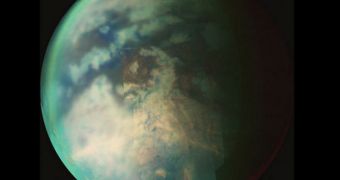New computer models that simulated possible chemical reactions in Titan's atmosphere concluded that the basic organic molecules need to create life may exist on the largest moon of Saturn.
The investigation basically states that carbon-based life forms are possible on the space object, which is one of the most interesting bodies in the solar system.
Data sent back from the NASA Cassini orbiter shows that the upper layers of the moon's atmosphere are very rich in nitrogen, a chemical vital to life here on Earth as well.
Using the new simulations, a research team modeled the chemical reactions that may take place in those particular chemical and physical conditions, and at Titan's temperatures and pressure levels.
Results showed that an unexpectedly-large number of organic molecules may exist in the atmosphere, including nucleotide bases and amino acids.
The former class of compounds is responsible for creating RNA and DNA, while the latter category can assemble in a variety of forms to give birth to proteins, the basic building blocks of complex life.
“We can do this entirely in an atmosphere. We don't need liquid water, we don't need a surface,” explains Sarah Horst, who is a graduate student at the University of Arizona.
“We show that it is possible to make very complex molecules in the outer parts of an atmosphere,” she adds in a statement, quoted by Space.
Among the molecules that were found to be possible in Titan's atmosphere, Horst mentioned all the five bases of the genetic code, cytosine, adenine, thymine, guanine and uracil.
In addition, the small amino-acids glycine and alanine were found to be possible as well. Details of the new work were presented yesterday, October 7, at the meeting of the American Astronomical Society's Division of Planetary Sciences.
One of the most interesting things about the new experiment is the fact that it represents the first time when such complex chemicals are produced in simulations without the addition of water.
The team that compiled the model says that it discovered and cataloged some 20,000 different types of molecules. They used mass spectrometry for the job.
As more and more studies about Titan are being published, it is becoming clear that the Saturnine moon, alongside Enceladus and Jupiter's Europa, will form the focus on new space exploration missions.
All these objects feature traits that hint at the possibility of life elsewhere in the solar system. And this is a possibility definitely worth investigating, Space reports.

 14 DAY TRIAL //
14 DAY TRIAL //